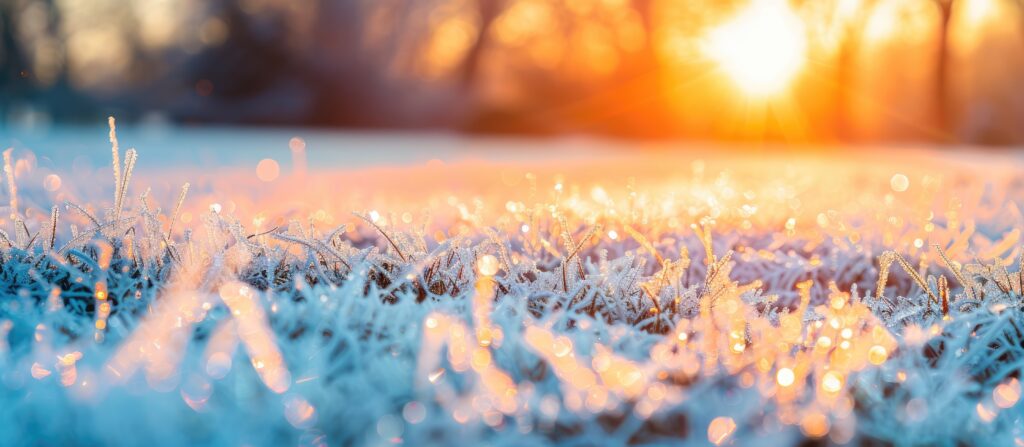Winter can be a harsh season for your lawn, with freezing temperatures, heavy snow, and ice posing potential threats to the health of your grass. While grass naturally enters dormancy during the colder months, it’s important to take proactive steps to protect it from environmental stressors. With a little care, you can ensure your lawn remains resilient and healthy as it rests during the winter months. Northern Roots Lawn Care is sharing our top tips for homeowners to help safeguard their lawns this winter.
Avoid Walking on Frozen Grass
Problem: Frozen grass is much more vulnerable than you might think.
When the ground is frozen and the grass is dormant, walking on the lawn can cause irreparable damage. The blades of grass can bend or break, and foot traffic can compact the soil, preventing air and water from reaching the roots. This damage can result in brown, patchy areas when the grass comes out of dormancy in spring.
Tip: Limit foot traffic on your lawn during the winter, especially when it’s covered in snow or frost.
If possible, create designated walkways or paths to avoid walking directly on the grass. If your lawn gets heavy use during the winter months (like children playing or pets running around), consider laying down some stepping stones or gravel paths to distribute weight more evenly.
Use De-Icers That Are Safe for Lawns
Problem: Salt and other chemicals can burn grass, damage soil structure, and even contaminate nearby water sources.
De-icers are commonly used on driveways and sidewalks to melt ice, but many traditional de-icing products—such as rock salt—can be harmful to your lawn. Fortunately, there are safer alternatives that won’t harm your lawn.
Tip: Opt for de-icers labeled as “safe for lawns” or “pet-safe.”
These products typically contain ingredients like potassium chloride or calcium magnesium acetate, which are less harmful to grass and the environment. If you don’t want to use de-icers at all, consider using sand or kitty litter for traction, which won’t melt the ice but will help reduce slipping hazards without harming your grass.
Keep Your Lawn Free from Debris
Problem: Fallen leaves, branches, and other organic debris can trap moisture and create a breeding ground for mold, mildew, and fungus.
Not only can organic debris cause mold and mildew, snow that falls on top of debris can also become matted, depriving the grass beneath of oxygen. It’s important to keep your lawn as clear as possible heading into winter.
Tip: Rake up any fallen leaves, sticks, or other debris from your lawn before the first snowstorm.
Taking care of leaves and debris in the fall will help keep the grass healthy and prevent any fungal growth during the winter. It also allows snow to fall evenly on the lawn, insulating it without causing damage.
Ensure Proper Lawn Care Before Winter Sets In
Problem: Lawns that haven’t been properly cared for in the fall are more susceptible to damage in winter.
One of the best ways to protect your lawn from winter damage is to prepare it properly during the fall. Healthy grass with well-established roots is better equipped to handle the stresses of cold weather. Proper fall care can make all the difference when winter comes around.
Tip: Preparation in the fall will ensure your lawn is healthy in the spring.
- Fertilize: Apply a slow-release fertilizer in the fall to ensure your lawn has enough nutrients to sustain it through the winter months. This will help the grass store energy in the roots, ensuring it’s ready to green up in the spring.
- Aerate: Aerating your lawn in the fall allows oxygen, water, and nutrients to reach the roots more effectively, which helps strengthen them ahead of the winter dormancy period. Aerating also relieves soil compaction, which can be worsened by freezing and thawing cycles.
- Mow Properly: Before the first frost, mow your lawn one last time, but avoid cutting it too short. Aim for a height of about 2-3 inches to allow the grass to stay strong but not too long, which could encourage snow mold or pest infestations.
Remember, a little winter care goes a long way. With these simple steps, you’ll be helping your lawn to thrive come spring, when it’s time for the grass to wake up and start growing again. And don’t forget, Northern Roots Lawn Care takes care of you all year long with our snow removal services. Contact us today to help keep your sidewalk or driveway clear!


